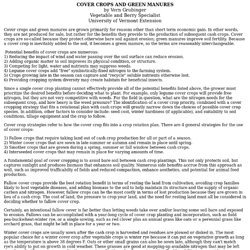

Cover Crop Guide. Brassica Cover Crops - Groundhog Daikon Radish. "One of the easiest and most economical ways to improve your soil is to plant green manures, commonly called cover crops.

Most garden soils can be maintained at their highest level of productivity by sound soil management practices that involve a combination of soil tillage, crop rotation, and most importantly, the addition of organic matter through green manures.Organic matter is the ''food'' component of soil. Soil-dwelling fungi and bacteria work to break down organic matter. When these soil microorganisms eat organic matter, nutrients are released back into the soil in a form that is usable by plants. This process is called nutrient cycling. Nutrient cycling affects both the physical and chemical properties of the soil. LegumeWinter season legume cover crops are an essential component of good soil management. Winter Cereal Grains and GrassCereal grains and grasses grow very quickly and provide quick ground cover, even in cool weather. (A) Annual(B) Biennial(P) Perennial" (Saving...) Green Manure Crops - Organic Gardening.
Garden magic from John Jeavons and Bill Bruneau.

Green manuring — growing green manure crops especially for their organic matter and ability to improve the soil — can dramatically build up poor and exhausted soils and maintain the fertility of better ones. Let me give you two examples from our own experience. When we first started Ecology Action of the Mid-peninsula in 1974, we were minifarming a site in the Stanford Industrial Park that had no topsoil or subsoil: It had all been scraped off in anticipation of future construction. Eight years later, we had improved the soil by using green manure crops to a depth of over two feet!
Then in 1982, we moved to our current steep hillside location in northern California. In both cases, we were able to dramatically improve the soil through deep cultivation, intensive plant spacing, the addition of composts and aged manures . . . and a continuous program of growing green manure crops. 244. Cover Crops and Green Manures. COVER CROPS AND GREEN MANURES by Vern Grubinger Vegetable and Berry Specialist University of Vermont Extension Cover crops and green manures are grown primarily for reasons other than short term economic gain.

In other words, they are not produced for sale, but rather for the benefits they provide to the production of subsequent cash crops. Cover crops are so-called because they protect otherwise bare soil against erosion; green manures improve soil fertility. Because a cover crop is inevitably added to the soil, it becomes a green manure, so the terms are reasonably interchangeable. Master Gardener: Stewardship Gardening - Planting and Growing Green Manures.
How Do I Work With Green Manures?

Choose the best plants for the time of year and the situation. Growing a mixture of green manures, for example a grass and a legume, is a good idea. Cover Crops: Hairy Vetch. Table of Contents Description Figure 1 - Well Established Hairy Vetch Figure 2 - Closeup of Hairy Vetch Flowers Family: Vicia species Winter annual legume Many cultivars Growth Habits Germination Vine-like growth habit - 12 to 20" (30-50cm) in monoculture Grows 3 to 4 ft (90-120cm) in height if sown with cereals - but actual vine length may be much longer 9 to 17 pairs of leaflets form leaves, each ending in a tendril 20 –30 blue-violet flowers are borne on one side of the flower stem Stems and leaves are hairy Top Growth Seeds are small, round, black and irregularly-sized Requires inoculant type "C" Root System Weak tap root (but can grow to 2 to 3 ft (60-90cm) (in depth) Shallow root system - most roots in top 20 cm Root growth can continue while plant is dormant Overwintering Overwinters Tolerates extremely cold conditions Site suitability Drought tolerant - once established Does best on sandy soils Does well on most soils if well drained Prefers soil pH of 6.0 to 7.0 Control Options.
Buckwheat. Crimson Clover. INTRODUCTION Crimson clover (Trifolium incarnatum) is a relatively new cover crop for Michigan.

Traditionally used further south, MSU researchers and southern Michigan farmers have used this annual clover effectively as a cover crop in corn, soybeans and wheat. Crimson clover has taller flower stems, grows more quickly and has larger seeds than the more commonly used red clover. Crimson clover's primary advantages are rapid growth during cool weather, shade tolerance and a positive reseeding potential. Thus, crimson clover can be planted early in spring or fall for weed control, or overseeded in corn at second cultivation or in soybeans at leaf drop.
Because of its shade tolerance and reseeding potential, crimson is also effective as a living cover in orchards. BENEFITS Crimson clover's many benefits include: ESTABLISHMENT Crimson clover can tolerate almost any soil type, but prefers loam soils with good drainage.